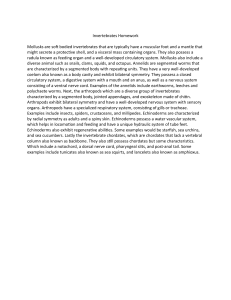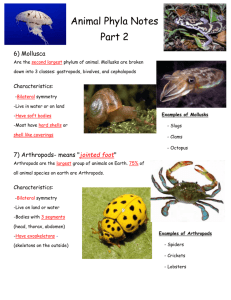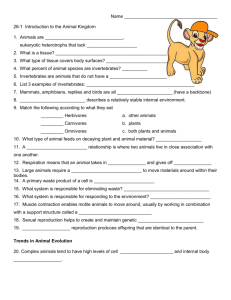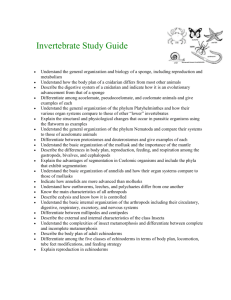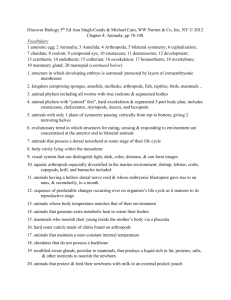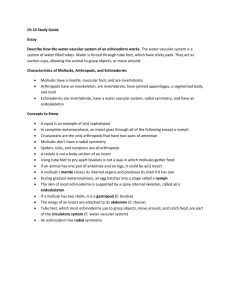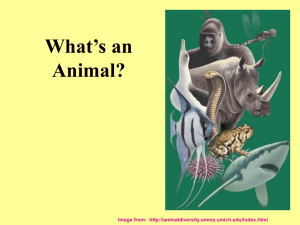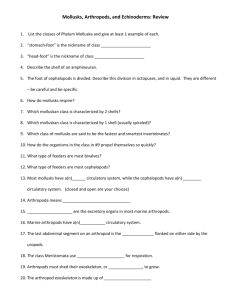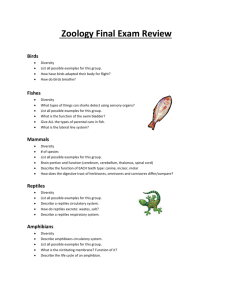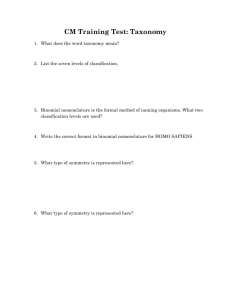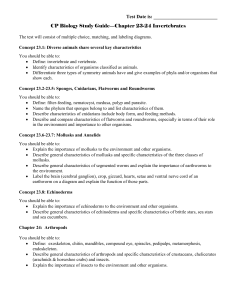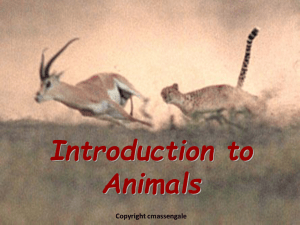Introduction to Animals
advertisement
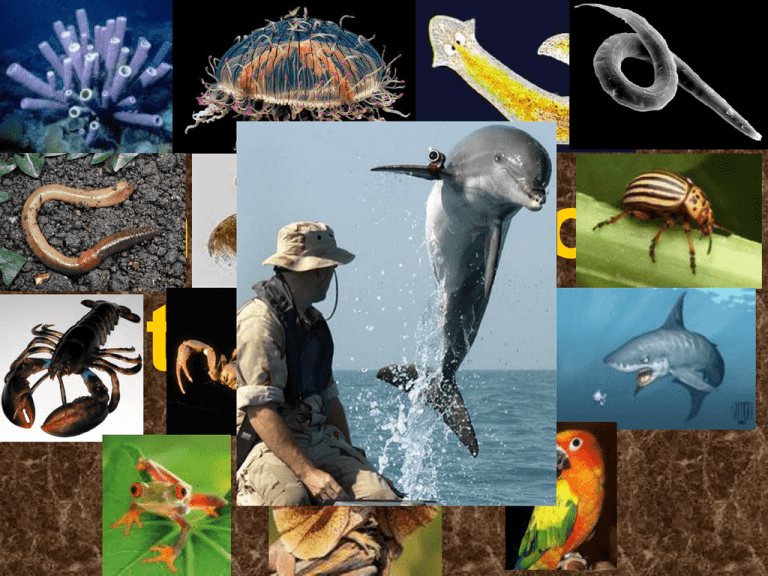
Introduction to Animals To be an animal means 1. Multicellular – humans have ~ 50 - 100 trillion cells 2. Ingestive heterotroph 3. Lacking a cell wall 4. Specialization of cells (except Porifera) 5. May involve movement & sexual reproduction (formation of a zygote) Phylogenetic tree of animal kingdom • Based on: – Body symmetry – Patterns of embryo development – Comparing fossils – rRNA Symmetry • Overall pattern of structure – Asymmetric - No symmetry as with the Porifera – Radial symmetry – even cut along a diameter. Echinodermata and Cnidaria – Bilateral symmetry – even cut along a central plane. Worms, Arthropods, Mollusks, Echinoderms, and Vertebrates Trends in Animal Evolution • As you go up the phylogenetic tree, you will see a greater tendency towards bilateral symmetry. • Also a concentration of nerves (sensory organs) towards the front of the organisms known as cephalization Body views 1. 2. 3. 4. Dorsal – top/back Ventral – belly/bottom Anterior – front/head Dorsal (top) Posterior – tail/rear Posterior (tail end) Anterior (front) Ventral (bottom) Cleavage • A series of cell divisions that occurs immediately following fertilization – Mitosis occurs but cells do not grow in size. Stages in Cleavage Blastula Zygote Morula Gastrula Indented ball stage Hollow ball stage Solid ball stage During gastrulation, an indentation occurs. A multi-layer embryo is formed with 3 germ layers Blastopore – opening of indentation • Protostome – Blastopore developes into the oral opening (mouth) – Mollusks, arthropods and annelids • Deuterostomes – Blastopore developes into anus – Echinoderms and Chordates (that’s us) Germ Layers • • • Fundamental tissue types found in embryos of animals (but not sponges) Gives rise to every body feature, organs & tissues 2 germ layers in Cnidaria & 3 in all others – – – Endoderm – forms throat, gills, lungs and digestive tract (with pancreas and liver) Ectoderm – forms outer skin, hair, nails and nervous system Mesoderm – skeleton, muscles, inner skin layer, circulatory system and lining of the body cavity Body Cavities • • • Acoelomates – Body cavity is absent. As in Flatworms . Endoderm is connected solidly to mesodermal tissue Pseudocoelomates – Body cavity contains three distinct layers but endoderm is not connected to mesoderm. Free floating in fluid. Found in roundworms. Coelomates – True body cavity. Mesoderm lines body cavity while supporting endodermic. Mollusks, annelids, arthropods, chordates and echinoderms Systems through the Phyla Circulatory systems • Closed Circulatory System – One in which blood is always contained within a vessel. Heart serves as a pump. Found in annelids, chordates Open Circulatory System – Pumps blood into spaces around the body tissues. From there the blood makes its way back to vessels that will carry it back to the heart, or possibly to holes in the heart itself. Found in Arthropods and some mollusks Skeletons Exoskeleton – Rigid, outer covering protecting soft internal tissue. Found in Arthropods and mollusks. Needs to be shed (molt) as animal grows. Endoskeleton – Internal skeleton. Best for larger organism. Found in echinoderms and vertebrates. Grows as animal grows. Reproduction: • • Asexually by budding (Porifera, Cnidarians) or regeneration (Porifera, Planaria, Sea stars) Sexually – – Hermaphroditic – contains both sexes (but not self fertilization necessarily). Think of your earthworm Separate sexes – as you go up the phylogenetic tree Development Incomplete metamorphosis – Direct development – young animal is born or hatched looking like adult but smaller. No larval stage. Mantids, Grasshoppers, us Complete metamorphosis – Indirect development – intermediate larval stages appearing different from adult. Butterfly, flies, moths
